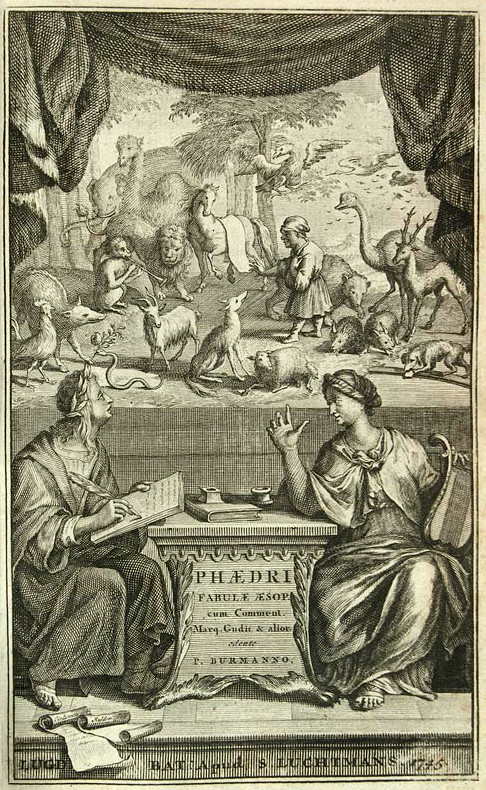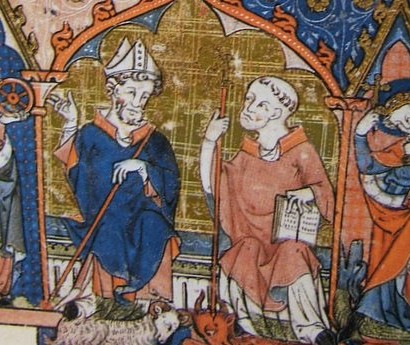|
Garbet
Samuel Garbet (d. 1751?) was an English topographer. Biography Garbet was born in Norton, in the parish of Wroxeter, Shropshire. He was educated at Donnington School and at Christ Church, Oxford, where he entered 12 June 1700, and graduated with a B.A. 23 May 1704, and a M.A. 5 July 1707. He was ordained as a deacon 22 Sept. 1706, and became curate of Great Ness. On 11 March 1712, he was elected second master of the free school at Wem, in Shropshire. In 1713, he became the curate of nearby Edstaston. In 1724 he was offered, but declined, the headmastership of the Wem school. In 1742, 'having y his own accountkept up the credit of the school for thirty years, and being in easy circumstances, he thought fit to retire,’ and devoted himself to the compilation of his 'History of Wem, and the following Villages and Townships,’ which was published posthumously in 1818 (Wem, 8vo). In 1715 he had published a translation of Phaedrus Phaedrus may refer to: People * Phaedrus ... [...More Info...] [...Related Items...] OR: [Wikipedia] [Google] [Baidu] |
Thomas Adams School
Thomas Adams School is a coeducational secondary school boarding school and sixth form in Wem, Shropshire, England. The school takes pupils from ages 11–18 and currently has just over 1,400 on roll. The school has the Schools for Health Award and in 2002 obtained Media Arts College status. History The school was founded in 1650 by Sir Thomas Adams, the Lord Mayor of London in 1645, who was described by the diarist Samuel Pepys as a "comely old alderman". He was a Sheriff of London, Master of the Company of Drapers and an MP. He was a staunch royalist, who was imprisoned in the Tower of London for his royalist sympathies but was later sent by Parliament to the Hague in 1660 to wait upon King Charles II who was about to be restored to the throne. He also paid for the Bible to translated into Persian. Adams Grammar School merged with Wem Secondary Modern School in 1976 to form Adams School, later named Thomas Adams School. In March 2020 the school joined The Priory Trust. ... [...More Info...] [...Related Items...] OR: [Wikipedia] [Google] [Baidu] |
Great Ness
Great Ness and Little Ness are civil parishes in Shropshire, England. Common Local Governance The two parishes share a parish council. The parishes cover the area surrounding the village of Nesscliffe, Hopton, Kinton, Willcot, Felton Butler and Alderton. They are represented on the unitary Shropshire Council, and in the Shrewsbury and Atcham Parliamentary constituency. The Great Ness and Little Ness Parish council meet on the first Tuesday of every month, except for January and August, at Nesscliffe Village Hall or Little Ness Village Hall. Great Ness - The Hamlet Great Ness is compact and consists of various styles of dwellings, many of which have become Listed Buildings. In total there are 25 Listed Buildings in the parish of Great Ness with a Grade II listing or higher. The Church of Saint Andrew, the Church of England parish church in Great Ness is protected by Grade I listing. It was mentioned in the Domesday Book as the "Manor of Nessham" due to it being one of th ... [...More Info...] [...Related Items...] OR: [Wikipedia] [Google] [Baidu] |
English People
The English people are an ethnic group and nation native to England, who speak the English language in England, English language, a West Germanic languages, West Germanic language, and share a common history and culture. The English identity is of History of Anglo-Saxon England, Anglo-Saxon origin, when they were known in Old English as the ('race or tribe of the Angles'). Their ethnonym is derived from the Angles, one of the Germanic peoples who migrated to Great Britain around the 5th century AD. The English largely descend from two main historical population groups the West Germanic tribes (the Angles, Saxons, Jutes and Frisians) who settled in southern Britain following the withdrawal of the Ancient Rome, Romans, and the Romano-British culture, partially Romanised Celtic Britons already living there.Martiniano, R., Caffell, A., Holst, M. et al. Genomic signals of migration and continuity in Britain before the Anglo-Saxons. Nat Commun 7, 10326 (2016). https://doi.org/10 ... [...More Info...] [...Related Items...] OR: [Wikipedia] [Google] [Baidu] |
Topographer
Topography is the study of the forms and features of land surfaces. The topography of an area may refer to the land forms and features themselves, or a description or depiction in maps. Topography is a field of geoscience and planetary science and is concerned with local detail in general, including not only relief, but also natural, artificial, and cultural features such as roads, land boundaries, and buildings. In the United States, topography often means specifically ''relief'', even though the USGS topographic maps record not just elevation contours, but also roads, populated places, structures, land boundaries, and so on. Topography in a narrow sense involves the recording of relief or terrain, the three-dimensional quality of the surface, and the identification of specific landforms; this is also known as geomorphometry. In modern usage, this involves generation of elevation data in digital form (DEM). It is often considered to include the graphic representation of the ... [...More Info...] [...Related Items...] OR: [Wikipedia] [Google] [Baidu] |
Wroxeter
Wroxeter is a village in Shropshire, England, which forms part of the civil parish of Wroxeter and Uppington, beside the River Severn, south-east of Shrewsbury. ''Viroconium Cornoviorum'', the fourth largest city in Roman Britain, was sited here, and is gradually being excavated. History Roman Wroxeter, near the end of the Watling Street Roman road that ran across Romanised Celtic Britain from '' Dubris'' (Dover), was a key frontier position lying on the bank of the Severn river whose valley penetrated deep into what later became Wales following brytons fall to the Anglo Saxons, and also on a route to the south leading to the Wye valley. Archaeology has shown that the site of the later city first was established about AD 55 as a frontier post for a Thracian legionary cohort located at a fort near the Severn river crossing. A few years later a legionary fortress (''castrum'') was built within the site of the later city for the Legio XIV Gemina during their invasion o ... [...More Info...] [...Related Items...] OR: [Wikipedia] [Google] [Baidu] |
Shropshire
Shropshire (; alternatively Salop; abbreviated in print only as Shrops; demonym Salopian ) is a landlocked historic county in the West Midlands region of England. It is bordered by Wales to the west and the English counties of Cheshire to the north, Staffordshire to the east, Worcestershire to the southeast, and Herefordshire to the south. A unitary authority of the same name was created in 2009, taking over from the previous county council and five district councils, now governed by Shropshire Council. The borough of Telford and Wrekin has been a separate unitary authority since 1998, but remains part of the ceremonial county. The county's population and economy is centred on five towns: the county town of Shrewsbury, which is culturally and historically important and close to the centre of the county; Telford, which was founded as a new town in the east which was constructed around a number of older towns, most notably Wellington, Dawley and Madeley, which is today th ... [...More Info...] [...Related Items...] OR: [Wikipedia] [Google] [Baidu] |
Donnington, Wroxeter And Uppington
Donnington is a hamlet in the English county of Shropshire. It forms part of the civil parish of Wroxeter and Uppington. It lies near to Charlton Hill, which rises to above sea level. The hamlet contained a now defunct 'free grammar school' under patronage of the Newport family during the 17th and 18th centuries whose pupils included Royalist divine Richard Allestree and Puritan divine Richard Baxter Richard Baxter (12 November 1615 – 8 December 1691) was an English Puritan church leader, poet, hymnodist, theologian, and controversialist. Dean Stanley called him "the chief of English Protestant Schoolmen". After some false starts, he ..., the latter of whom taught at the school for three months. Welsh poet Goronwy Owen was master at the school as well as curate at Uppington, from 1748 to 1753. References External links * Hamlets in Shropshire {{Shropshire-geo-stub ... [...More Info...] [...Related Items...] OR: [Wikipedia] [Google] [Baidu] |
Christ Church, Oxford
Christ Church ( la, Ædes Christi, the temple or house, '' ædēs'', of Christ, and thus sometimes known as "The House") is a constituent college of the University of Oxford in England. Founded in 1546 by King Henry VIII, the college is uniquely a joint foundation of the university and the cathedral of the Oxford diocese, Christ Church Cathedral, which both serves as the college chapel and whose dean is ''ex officio'' the college head. The college is amongst the largest and wealthiest of colleges at the University of Oxford, with an endowment of £596m and student body of 650 in 2020. As of 2022, the college had 661 students. Its grounds contain a number of architecturally significant buildings including Tom Tower (designed by Sir Christopher Wren), Tom Quad (the largest quadrangle in Oxford), and the Great Dining Hall, which was the seat of the parliament assembled by King Charles I during the English Civil War. The buildings have inspired replicas throughout the world in a ... [...More Info...] [...Related Items...] OR: [Wikipedia] [Google] [Baidu] |
Phaedrus (fabulist)
Gaius Julius Phaedrus (; grc-gre, Φαῖδρος; Phaîdros) was a 1st-century CE Roman Empire, Roman fabulist and the first versifier of a collection of Aesop's fables into Latin. Few facts are known about him for certain and there was little mention of his work during late antiquity. It was not until the discovery of a few imperfect manuscripts during and following the Renaissance that his importance emerged, both as an author and in the transmission of the fables. Biography A recent statement of the few facts that past scholars have tried to deduce from autobiographical hints given by Phaedrus in his poems has summarised them as follows: He was born in Macedonia, probably in Pydna, about 15 BCE, came to Rome as a slave and was freed by Augustus. He probably had some teaching function between then and the time of Tiberius, under whom the first book of his poems appeared. Envious competitors interpreted the morals of some fables as being critical of the regime and he was trie ... [...More Info...] [...Related Items...] OR: [Wikipedia] [Google] [Baidu] |
Worcester, England
Worcester ( ) is a cathedral city in Worcestershire, England, of which it is the county town. It is south-west of Birmingham, north-west of London, north of Gloucester and north-east of Hereford. The population was 103,872 in the 2021 Census. The River Severn flanks the western side of the city centre. It is overlooked by Worcester Cathedral. Worcester is the home of Royal Worcester, Royal Worcester Porcelain, composer Edward Elgar, Lea & Perrins, makers of traditional Worcestershire sauce, the University of Worcester, and ''Berrow's Worcester Journal'', claimed as the world's oldest newspaper. The Battle of Worcester in 1651 was the final battle of the English Civil War, during which Oliver Cromwell's New Model Army defeated Charles II of England, King Charles II's Cavalier, Royalists. History Early history The trade route past Worcester, later part of the Roman roads in Britain, Roman Ryknild Street, dates from Neolithic times. It commanded a ford crossing over the Rive ... [...More Info...] [...Related Items...] OR: [Wikipedia] [Google] [Baidu] |






